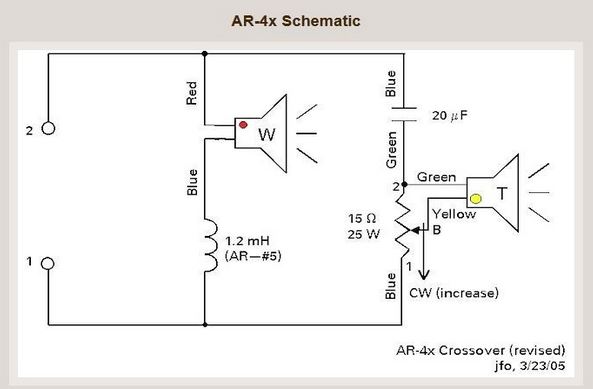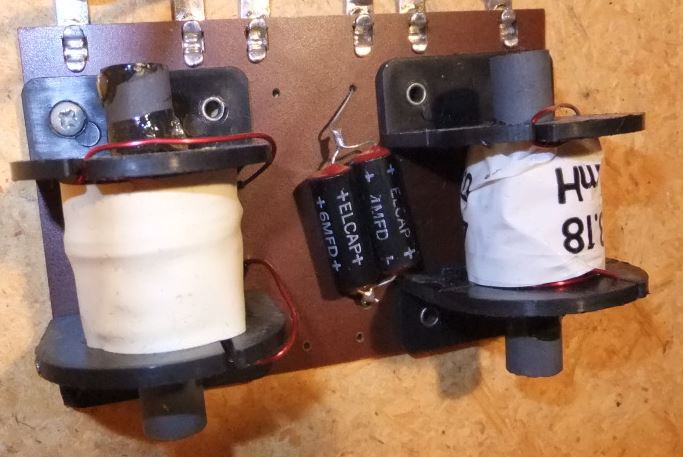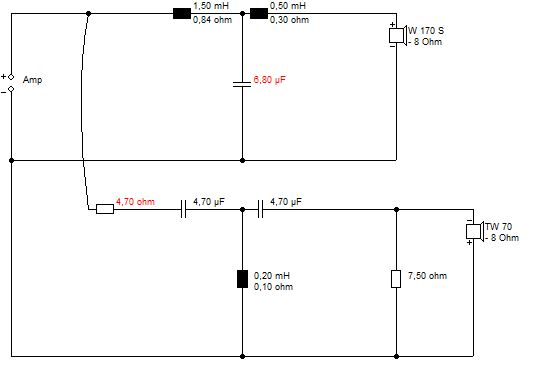Hi guys!
I already know my question is very strange, but being a newbie, I've this curiosity.
If I have a 12 watt power amplifier (at 4 ohm) and a little cone Peerser tweeter (MT-25 HFC/4 ohm) with a 10uF capacitor connected to it, approximately how many watt I'm leading to the tweeter in question?😕
Sorry again for this stupid question.🙁
Thank you in advance for your patience
Best Regards.
I already know my question is very strange, but being a newbie, I've this curiosity.
If I have a 12 watt power amplifier (at 4 ohm) and a little cone Peerser tweeter (MT-25 HFC/4 ohm) with a 10uF capacitor connected to it, approximately how many watt I'm leading to the tweeter in question?😕
Sorry again for this stupid question.🙁
Thank you in advance for your patience

Best Regards.
It will handle only very little power, so just play music at a reasonable volume. Only a fraction of a watt
is needed. The amount of power the tweeter gets depends on the type of music, as well as the volume.
The 10uF capacitor only allows the tweeter to get the overtones in the music.
is needed. The amount of power the tweeter gets depends on the type of music, as well as the volume.
The 10uF capacitor only allows the tweeter to get the overtones in the music.
Last edited:
The following explanation of what the capacitor does is grossly over-simplified, but I hope that it will help you:
1. Impedance is a measure of the ability of a component to resist the passage of electricity.
2. The impedance of a capacitor reduces at higher frequencies.
3. A 10 uF capacitor has an impedance of 16 Ohms at 1 KHz, which reduces to 4 Ohms at 4 KHz.
So at 4 KHz a 10 uF capacitor and 4 Ohm speaker have the same magnitude impedance. This point is called the turnover. Because the capacitor is in series with the speaker, it reduces the flow of electricity to the speaker at lower frequencies.
1. Impedance is a measure of the ability of a component to resist the passage of electricity.
2. The impedance of a capacitor reduces at higher frequencies.
3. A 10 uF capacitor has an impedance of 16 Ohms at 1 KHz, which reduces to 4 Ohms at 4 KHz.
So at 4 KHz a 10 uF capacitor and 4 Ohm speaker have the same magnitude impedance. This point is called the turnover. Because the capacitor is in series with the speaker, it reduces the flow of electricity to the speaker at lower frequencies.
I've just realised that I did not actually annswer your question. So here goes...
- At 4KHz, the capacitor halves the power fed to the tweeter (i.e. -3dB).
- At 2KHz, the power fed to the tweeter is reduced to 1/8th (-9dB).
- At 1KHz, cumulative reduction 1/32nd (-15dB).
- At 500Hz, cumulative reduction 1/128th (-21dB).
and so on...
I hope that is intelligible.
- At 4KHz, the capacitor halves the power fed to the tweeter (i.e. -3dB).
- At 2KHz, the power fed to the tweeter is reduced to 1/8th (-9dB).
- At 1KHz, cumulative reduction 1/32nd (-15dB).
- At 500Hz, cumulative reduction 1/128th (-21dB).
and so on...
I hope that is intelligible.
hi peters8,
I found the attached datasheet, stating 1,5 W maximum effective power for your tweeter, that's not very much.
adding a 10uF capacitor results in a first order crossover at 4kHz that is a basic protection but still lets some lower frequency energy to the tweeter.
a VERY rough estimation based on pink noise energy distribution and a perfect 1st-order filter would result in around 5% of total power directed to the tweeter, which is about 0,6 W from your amplifier.
however, the tweeter has a impedance maximum at fs (1,5 kHz), so you will get some more power into the tweeter around that frequency than expected for 4 ohms.
also, your amplifier can deliver 12 watts at any frequency and if you do not only play pink noise ;-) or music with similar distribution, it may overload the tweeter rather quickly.
so you could either be careful with your volume or use a 2nd order crossover or increase the crossover frequency ... or all together!
I found the attached datasheet, stating 1,5 W maximum effective power for your tweeter, that's not very much.
adding a 10uF capacitor results in a first order crossover at 4kHz that is a basic protection but still lets some lower frequency energy to the tweeter.
a VERY rough estimation based on pink noise energy distribution and a perfect 1st-order filter would result in around 5% of total power directed to the tweeter, which is about 0,6 W from your amplifier.
however, the tweeter has a impedance maximum at fs (1,5 kHz), so you will get some more power into the tweeter around that frequency than expected for 4 ohms.
also, your amplifier can deliver 12 watts at any frequency and if you do not only play pink noise ;-) or music with similar distribution, it may overload the tweeter rather quickly.
so you could either be careful with your volume or use a 2nd order crossover or increase the crossover frequency ... or all together!
Attachments
Last edited:
Just for fun, here's a few cone tweeter implementations, albeit 8 ohm tweeters, AFAIK:
First order

Second Order

Third order

10uF should be alright IMO. Exact implementation and crossover depends on the woofer.
First order
Second Order
Third order
10uF should be alright IMO. Exact implementation and crossover depends on the woofer.
hi peters8,
I found the attached datasheet, stating 1,5 W maximum effective power for your tweeter, that's not very much.
adding a 10uF capacitor results in a first order crossover at 4kHz that is a basic protection but still lets some lower frequency energy to the tweeter.
a VERY rough estimation based on pink noise energy distribution and a perfect 1st-order filter would result in around 5% of total power directed to the tweeter, which is about 0,6 W from your amplifier.
however, the tweeter has a impedance maximum at fs (1,5 kHz), so you will get some more power into the tweeter around that frequency than expected for 4 ohms.
also, your amplifier can deliver 12 watts at any frequency and if you do not only play pink noise ;-) or music with similar distribution, it may overload the tweeter rather quickly.
so you could either be careful with your volume or use a 2nd order crossover or increase the crossover frequency ... or all together!
Thank you my friend! that 's what I was searching for.😉
Regards!🙂
- Home
- Loudspeakers
- Multi-Way
- Little cone Peerless Tweeter with a 10uF capacitor:how power it takes from the ampli?

